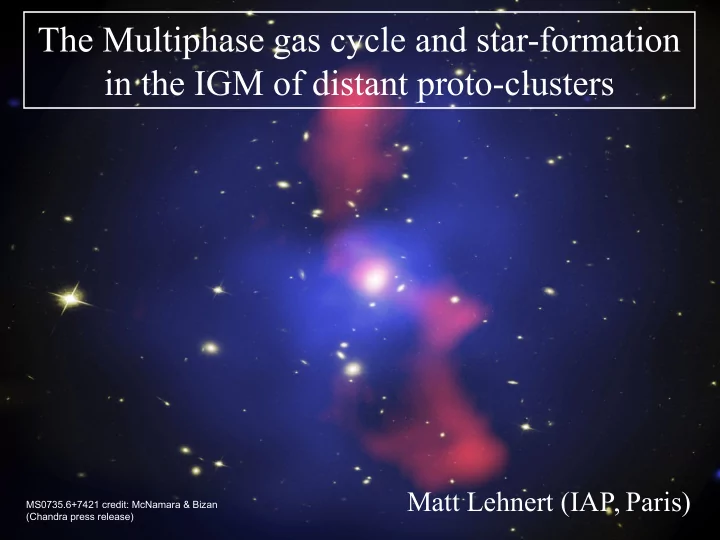

The Multiphase gas cycle and star-formation in the IGM of distant proto-clusters Matt Lehnert (IAP, Paris) MS0735.6+7421 credit: McNamara & Bizan (Chandra press release)
Theoretical problems in galaxy evolution Theoretical problems in galaxy evolution Galaxy formation is a balance between accretion, SF, and outflows. Is over- cooling still a problem in models? However, the balance is based on understanding what regulates each and they are on different scales. Turbulence has a role over many scales. Turbulent injection on large scales can increase the cooling time and could perhaps play a role in regulating the gas content, changing this balance. Turbulence connects phases through a mass, momentum, and energy flow. Thermal instabilities naturally generates turbulence. While global heating may balance the overall cooling, the energy injection into gas can still cause local cooling and hence thermal and kinematic instabilities through entropy fluctuations.
The nature of turbulence The nature of turbulence Turbulent injection on large scales can increase the cooling time and since it is an energy, momentum, phase flow, naturally results in a multiphase medium How do stars form in a halo? Dissipation of turbulence is key. t diss > t SF implies, no SF.
Dissipation of mechanical energy Dissipation of mechanical energy SPITZER IRS observations suggest strong dissipation of turbulence in the warm molecular gas through slow molecular shocks … but where is this taking place? Ogle et al. (2012)
The “Spider web” The “Spider web” Ly-alpha + HST 814W J-band + Dynamics with SINFONI 33” 22” Best studied radio galaxy embedded in a proto-cluster … at z=2.16, has a high stellar mass, ~few x 10 11 solar masses, giant Ly-alpha halo … Jets are powerful, will pump about 10 60 erg or more into the halo – about the binding energy of a massive galaxy! Miley et al. (2006), Kuiper et al. (2011)
Difguse star formation Difguse star formation Deep UV imaging from HST g 475 with galaxies removed to emphasize diffuse light g 475 +I 814 +J 110 +H 160 300x300 kpc Ruled out faint cluster galaxies, nebular continuum, scatter QSO light, etc. favoring in situ star formation Hatch et al. (2008; 2011)
Difguse CO(1-0) emission Difguse CO(1-0) emission Large halo of CO emission. Not from the galaxies, VLA rules that out. Emonts et al. (2016, submitted)
Difguse CO(1-0) emission Difguse CO(1-0) emission CO(1-0) at 115 GHz shifted into the radio Emonts et al. (2016, submitted)
Difguse CO(1-0) emission Difguse CO(1-0) emission Velocity of the CO is much different from that of the gas. Not from the galaxies. Emonts et al. (2016, submitted), Hatch et al. (2008)
Star forming like galaxies but in a halo! Star forming like galaxies but in a halo! How do stars form in a halo? Emonts et al. (2016, submitted)
Questions Questions These results raise a lot of questions: 1) What is the source of the extended gas? 2) How do stars form in such gas? 3) Does the radio jet also cause cooling in the halo? 4) Is this analogous to star formation seen in cluster gas at low redshift? Perhaps we can address some of these questions by looking at the energy dissipation in the gas.
ALMA Cycle 1 observations ALMA Cycle 1 observations In cycle 1, we proposed to observe the Spider web for ~50 minutes in: H 2 0 2 11 -2 02 @ 753.03 GHz [CI] 3 P 2 – 3 P 1 @ 809.34 GHz CO(7-6) @ 806.65 GHz 235 GHz continuum (~775 GHz continuum in the rest-frame) These observations were intended to: *trace the diffuse and dense molecular gas *trace the dissipation of mechanical energy through slow molecular shocks in dense gas. Address questions of: What is the impact of the radio jets on the dense circum-nuclear molecular gas? Where does the mechanical energy go? Is some of it dissipated through turbulence in the dense molecular gas?
Water in astrophysical plasmas Water in astrophysical plasmas H 2 O could be the most abundant molecular after H 2 , it's not. Along with CO, carries most of the O. How does it form?
The Quantum mechanics of water The Quantum mechanics of water 3 quantum numbers, J, K A , K C with permanent dipole, μ. These are total angular momentum and its two projections. ΔJ=0, +-1. ΔK A , ΔK C = +-1 or +-3 plus 3 unequal moments of inertia means large N of closely spaced transitions Large dipole moment allows for fast dipole transitions. H 2 O is an important coolant for dense gas with T~100-1000 K Levels determined by T ex , which can be either T rad or T collisional Shocks IR pumping
Dew drops in a dusty web Dew drops in a dusty web Not in the radio galaxy, but in the halo Gullberg et al. (2016)
Dew drops in a dusty web Dew drops in a dusty web Strong water emission implies dissipation in slow, 10-40 km/s, molecular shocks in dense gas, 10 3 to 10 5 H 2 cm -2 . Rapid dissipation of mechanical energy from the jet. Water winks on and off as energy dissipates. Gullberg et al. (2016)
A “model” A “model” Do the clouds dissipate turbulence rapidly enough to form stars? ALMA cycle 4 proposal to find out.
Some fjnal thoughts Some fjnal thoughts The questions we are asking are often not well formulated. What is it exactly what we “want” AGN to do? Is this a channel through which BCGs form their extended stellar halos? For this, we need to start to figure out how AGN might heat and lead to instabilities in halo gas.
Recommend
More recommend